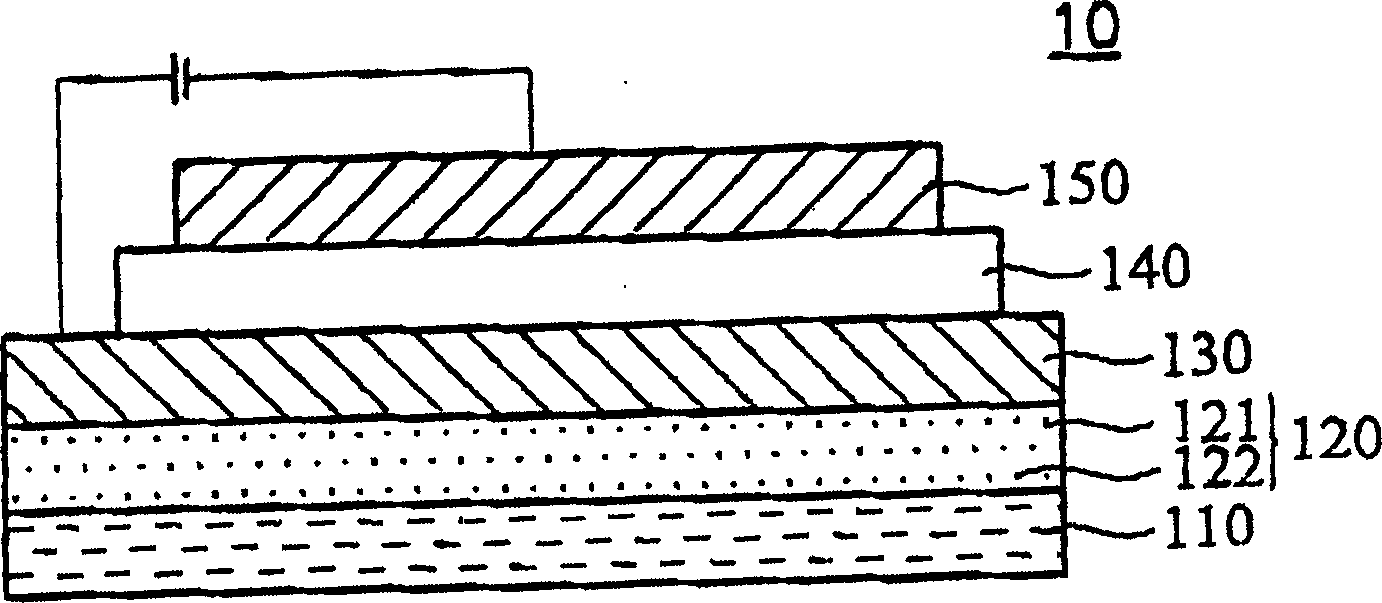Organic electroluminesence device
An electroluminescence, organic light-emitting layer technology, applied in electroluminescence light sources, electric light sources, lighting devices, etc., can solve the problems of less than 20% external electronic efficiency and high refractive index, achieve a simple production process and improve luminous efficiency Effect
- Summary
- Abstract
- Description
- Claims
- Application Information
AI Technical Summary
Problems solved by technology
Method used
Image
Examples
Embodiment 1
[0035] First, a substrate 110 is provided, please refer to FIG. 1 . The substrate 110 can be a transparent substrate or an opaque substrate, and is made of glass or plastic material (bendable substrate). On this substrate 110, a nanostructure organic electroluminescence light extraction layer 120 composed of a dielectric material or an organic material 121 and a nano-scale metal particle 122 is formed, and the above-mentioned nanostructure The dielectric material or organic material 121 of the organic electroluminescence light extraction layer and the metal particles 122 with nanometer size are formed simultaneously in the same or different ways, and the metal particles 122 with nanometer size are doped in the form of dopant Doping in the dielectric material or organic material 121 . The dielectric material of the above-mentioned organic electroluminescent light extraction layer that constitutes the nanostructure is silicon oxide (SiOx), aluminum oxide (AlOx), magnesium oxide...
Embodiment 2
[0037] First, a substrate 210 is provided, please refer to FIG. 2 . The substrate 210 can be a transparent substrate or an opaque substrate, and is made of glass or plastic material (flexible substrate). A first electrode 230 is formed on the substrate 210, and the first electrode 230 can be a transparent electrode, a metal electrode or a composite electrode. Next, a nanostructured organic electroluminescent light extraction layer 220 composed of a dielectric material or an organic material 221 and a nano-scale metal particle 222 is formed on the first electrode 230, and the above-mentioned The dielectric material or organic material 221 and the metal particles 222 with nanometer size that constitute the nanostructured organic electroluminescent light extraction layer 220 are formed simultaneously in the same or different ways, and the above-mentioned metal particles 222 with nanometer size are formed as dopants ( dopant) in the form of doping (doping) in the dielectric mater...
Embodiment 3
[0039] First, a substrate 310 is provided, please refer to FIG. 3 . The substrate 310 can be a transparent substrate or an opaque substrate, and is made of glass or plastic material (flexible substrate). A first electrode 330 is formed on the substrate 310, and the first electrode 330 can be a transparent electrode, a metal electrode or a composite electrode. Next, an organic light-emitting layer 340 is formed on the first electrode 330, and the organic light-emitting layer 340 can be a small molecule or polymer organic light-emitting material. Next, a nanostructured organic electroluminescence light extraction layer 320 composed of a dielectric material or an organic material 321 and metal particles 322 with a nano-scale (nano-scale) is formed on the organic light-emitting layer 340, and the above-mentioned composition The dielectric material 321 of the nanostructured organic electroluminescent light extraction layer and the metal particles 322 with nanometer size are formed...
PUM
 Login to View More
Login to View More Abstract
Description
Claims
Application Information
 Login to View More
Login to View More - R&D
- Intellectual Property
- Life Sciences
- Materials
- Tech Scout
- Unparalleled Data Quality
- Higher Quality Content
- 60% Fewer Hallucinations
Browse by: Latest US Patents, China's latest patents, Technical Efficacy Thesaurus, Application Domain, Technology Topic, Popular Technical Reports.
© 2025 PatSnap. All rights reserved.Legal|Privacy policy|Modern Slavery Act Transparency Statement|Sitemap|About US| Contact US: help@patsnap.com



